1) 鐔 秋草に虫図 美濃 (無銘)
Design of autumn flowers with insects by Mino School
SOLD |
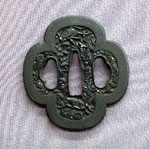 |
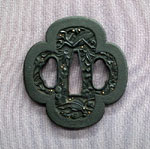 |
1) 鐔 秋草に虫図 美濃 (無銘)
寸法:縦64.0×横59.0×厚さ5.5 (mm)
解説:美濃鐔伝統の秋草に蟷螂や鈴虫などを配し、秋の情景が楽しめる。
幅広耳には魚々子が細かく打たれ、黒味の良い赤銅地に金の露象嵌を上品に施した優品。
江戸時代初期。保存鑑定書付。
Autumn flowers and insect such a mantis, bell cricket are depicted lively
on the good
Shakudo ground.
This is a traditional combination design of the Mino School (Mino = present Gifu prefecture),
it is very pleasing art work of this school. Circa 1600. Hozon certificate paper. |
2) 鐔 米俵図 銘 武陽住一安(花押)
Design of straw rice bags by Buyo ju Kazuyasu. |
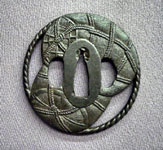 |
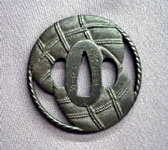 |
2) 鐔 米俵図 銘 武陽住一安(花押)
寸法:縦74.0×横72.0×厚さ5.0(mm)
解説:豊作の願いが込められた図柄で、毛彫りで米俵が立体的に表現され状態も良い。
福徳の神「大黒天」は米俵に乗っており、その留守模様図として吉祥の意味も持つ。
江戸時代後期。特別保存鑑定書付。
Design of straw rice bags by Buyo ju Kazuyasu.
This maker, Kazuyasu was active at Buyo (=Edo, present Tokyo) in 19th century.
It is thought that the wish of the good harvest is put in such the design,
and has a relationship with the god of wealth, Daikokuten.
(Daikokuten stands on the straw rice bags having the mallet of luck and the big bag.)
The straw rice bags are depicted with high carving technique and it has been preserved well.
Tokubetsu-Hozon certificate paper. |
3)鐔 餅搗用具透図(兎留守模様図) 大野(無銘)
Design: Tools for pounding steamed rice into rice cake by Ono School. |
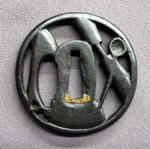 |
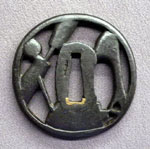 |
3) 鐔 餅搗用具透図(兎留守模様図) 大野(無銘)
寸法:72.0×横72.0×厚さ7.0 (mm)
解説:現在の愛知県知多半島に居住していたと伝わる大野派は、
鉄鐔の一大勢力である尾張・金山鐔とも深い関係性があると考えられている。
本作は厚い造り込みに、黒くねっとりとした鉄色がその特徴を表しており
流れるような曲線は、味わいのある雰囲気を出している。
本作は、主人公(兎)自体を描かず、関連した図柄(臼や杵)を表現した、
いわゆる留守模様となっている。
貴族等の間では古くから月を愛でる慣習があり、特に秋に月見の宴を催した。
月には兎がいるという伝承があり、杵で餅、または不老不死の薬を打っていると云われ
長寿を願う貴族や武士等に好まれ、日本文化に浸透している。
桃山時代(16世紀)。特別保存刀装具鑑定書付。
Design: Tools for pounding steamed rice into rice cake by Ono School.
Ono School has a deep relationship with powerful schools in the iron Tsuba,
Owari and Kanayama School and they have some similar characteristics.
This rust color is natural and good iron condition, it appears characteristic of Ono School.
This kind of style in design is usually called Rusu-moyo, a main character
(a hare) is not found,
only related designs to a main character (a mortar and a mallet) are depicted.
From the old time, it is said that a hare pounds steamed rice or the elixir
of life with a mallet
in the moon and has a meaning of longevity etc.
To enjoy seeing the moon and hold a banquet in autumn is very important season’s custom
for aristocrats who wish one’s prosperity.
Late 16th century. Tokubetsu hozon certificate paper |
4) 鐔 虫尽し図 無銘 武州
Design of seasonable insects by Bu-shu school.
SOLD |
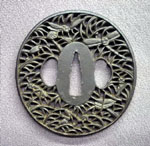 |
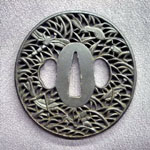 |
4) 鐔 虫尽し図 無銘 武州
寸法:縦81.0×横77.0×厚さ4.5 (mm)
解説:日本の風物詩として古くから文学や詩歌に登場する蟷螂(かまきり)、蜻蛉、蜂、蝶など
虫尽しを鉄地透かしし、晩夏初秋を表現している大振りな作。江戸時代中期。保存鑑定書付。
Design of seasonable insects such as a mantis, a dragonfly, a bee and a butterfly etc.
These insects are often depicted in literature and poem from old times as a seasonable motif.
It gives us an impression of late summer and early autumn.
This maker is attributed to a metal worker who was active in Bu-shu
(=Musahi province, present around Tokyo and Saitama area.). 18th century. |
5) 小柄 御木曳き図 銘 紋廉乗 光美(花押)
Design: “Okihiki” |
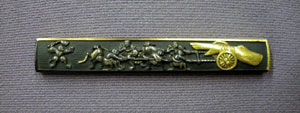
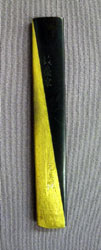
|
5) 小柄 御木曳き図 銘 紋廉乗 光美(花押)
寸法:縦14.0×横96.0(mm)
解説:御木曳きとは伊勢神宮(三重県)で20 年に一度行われる式年遷宮に
際し行うご神体であるご用材を移す伝統行事で、本作ではその様子が良く見て取れる。
近年では平成8年・平成19年に行われた。
式年遷宮とは御社殿を新しくお造りし、ご神宝なども新しく整え、新宮へ遷御いただく
祭儀をいう。
後藤宗家10代廉乗(光侶)の小柄で15代光美の極め。
江戸時代初期。(17世紀) 特別保存鑑定書付。
Design: “Okihiki” (Scene of carrying Japanese cypress for new building)
by Goto Renjo,
attested by Goto Mitsuyoshi
Okihiki is one of the ceremonies in Shikinen Sengu which is traditional
ceremony of
Ise-jingu (Mausoleum for ancestry of Imperial family).
This is made by Goto Renjo (Mitsutomo) who is the 10th mainline master
of Goto School in
17th century, and it is attested by Goto Mitsuyoshi who is the 15th mainline
master of Goto
School in 19th century. Tokubetsu-Hozon certificate paper. |
6) 目貫 秋草図 古美濃 (無銘)
Design of autumn flowers by Ko-Mino School |

|
 |
6) 目貫 秋草図 古美濃 (無銘)
寸法:左) 縦16.0×横47.0 (mm) 右) 縦16.0×横46.0 (mm)
解説:秋草を愛でる気持ちは古来より深く、特に美濃金工に好んで用いられ多くの名品を
残している。古美濃は、美濃彫りの技術が用いられた室町から桃山期にかけて製作された
古作を指し格調高いその作柄は広く愛好されている。
桃山時代。保存鑑定書付。
Japanese people have been enjoyed the beauty of autumn flowers since old
time.
This is a fine Menuki of Ko-Mino school in Momoyama period (16c.),and they
are especially
good at describing the autumn scene like this one, have left many fine
works.
Ko-Mino indicates an old metal worker using Mino carving technique which
was
active before Edo period.
Hozon certificate paper. |